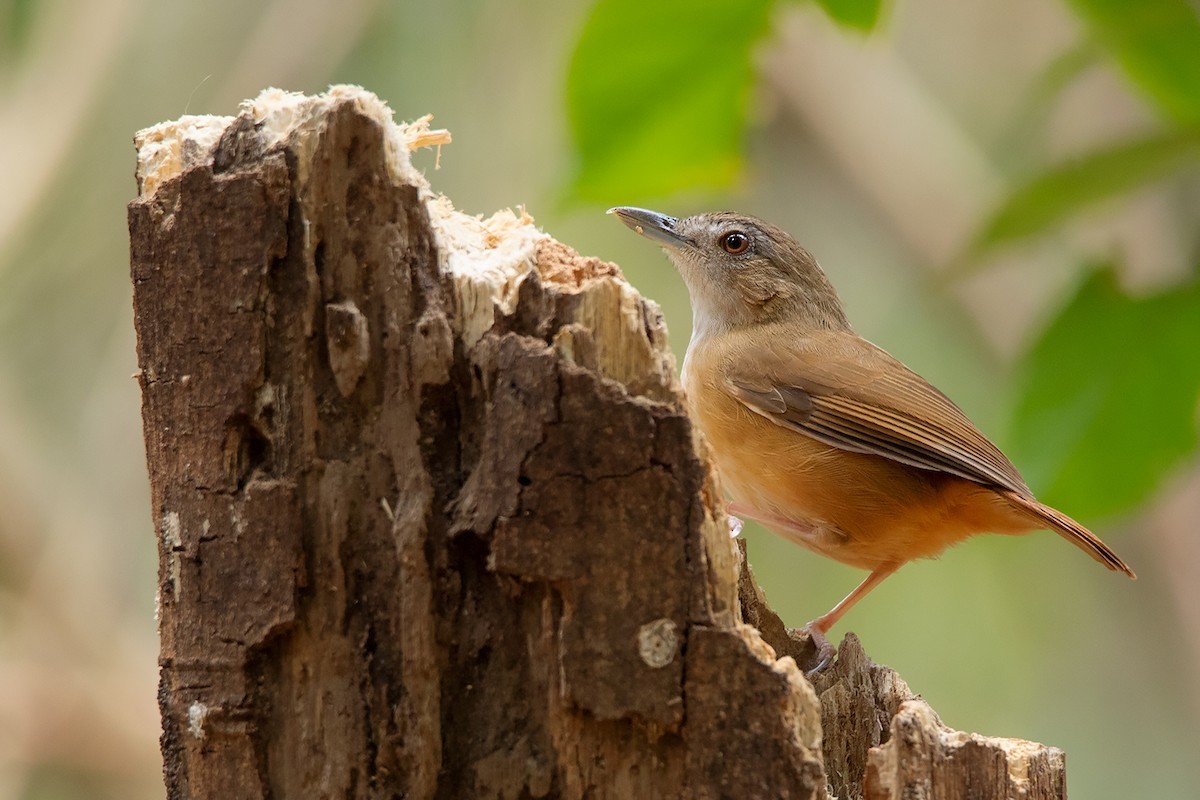Abbott's Babbler
A species of Babbler Scientific name : Malacocincla abbotti Genus : Babbler
Abbott's Babbler, A species of Babbler
Botanical name: Malacocincla abbotti
Genus: Babbler
Content
Description General Info
 Photo By Ayuwat Jearwattanakanok
Photo By Ayuwat Jearwattanakanok Description
The adult Abbott's babbler is a nondescript, brown, short-tailed, babbler that moves about in the low vegetation often near streams and in the vicinity of tree ferns and tangled vegetation. The throat is grey-white while the center of the belly is white and the flanks are olive. The undertail coverts are rusty-colored. The sexes are alike. It has a short tail and heavy bill; it is drab olive-brown with bright rusty lower flanks and vent, a greyish-white throat and breast and variable pale grey supercilium and lores. Juvenile birds have dark rufescent-brown crowns and upperparts. The calls are distinctive. The subspecies M. a. krishnarajui of the Eastern Ghats has a darker russet tail and rump than the Himalayan nominate subspecies. Specimens measure 12–13 cm (4.7–5.1 in) in length, with a head of 39–44 mm (1.5–1.7 in) and tail of 55–61 mm (2.2–2.4 in). 
Size
17 cm
Nest Placement
Ground
Feeding Habits
Abbott's Babbler consumes a variety of insects and other invertebrates, often foraging alone or in pairs on or near the ground. It sifts through leaf litter and prods into low vegetation with slow, deliberate movements. Abbott's Babbler has a preference for ground-level feeding.
Habitat
Abbott's Babbler thrives in diverse ecosystems, mainly favoring degraded evergreen forests, including semi-evergreen, and riverine forests. This species is commonly found in peatswamp forests, mangrove fringes, and areas with nipa palms. They exhibit a preference for dense vegetation, forest peripheries, and secondary growth regions, adapting to coastal scrubs, fire-tolerant scrublands, and nutrient-poor forest soils across broad geographical areas.
Dite type
Insectivorous
General Info
Feeding Habits
Bird food type
Behavior
Abbott's babbler usually moves around in pairs close to the ground. They breed from April to July (summer monsoon), with the nest being a carefully placed but bulky cup low in palms or other undergrowth. A study in Thailand found that most nests are placed in spiny palms and rattans. The usual clutch is 3 to 5 eggs which are bright salmon with dark blotches and red lines. When disturbed at the nest, the bird slip over the edge and fly with laboured wing beats and then hop out of sight. More than one brood may be raised in a season. Their distinctive calls consists of three or four notes with the a drop on the middle note. The antiphonal duet of a male and female has the male leading with a "poor'ol bear" followed by the females "dear dear". The tunes may however change over time. The birds tend to remain within a well marked area and do not wander widely. The song is a variable short series of around three to four notes of rich, fluty, liquid, slurred, short whistled notes; these are sometimes delivered haltingly and sometimes rapidly. The evening group song consists of a recurrent sputtering churrr sound, which is low and slurred; ending with a sharp chreep. Calls include soft mewing notes, and a pulsing, purring trill when agitated. 
Distribution Area
In South Asia, Abbott's babbler is resident from Nepal to Arunachal Pradesh and the Assam Valley in India, south throughout the South Assam hills, including Meghalaya and south through the Lushai Hills. It is also resident in east and south Bangladesh (around Jessore and Khulna), and the Eastern Ghats in North-east Andhra Pradesh and Odisha. It occurs up to 600 m (2000 ft), 275 m (900 ft) in Nepal. It is widely distributed across Southeast Asia. It is common across much of its large range. It is seen in the understory of broadleaved evergreen forest, forest edge, secondary growth and scrub. In Singapore, they have been noted as being tolerant to disturbance and adapting to secondary growth and disturbed forest. 

 Photo By Ayuwat Jearwattanakanok
Photo By Ayuwat Jearwattanakanok Scientific Classification
Phylum
Chordates Class
Birds Order
Perching birds Family
Jungle babblers Genus
Babbler Species
Abbott's Babbler